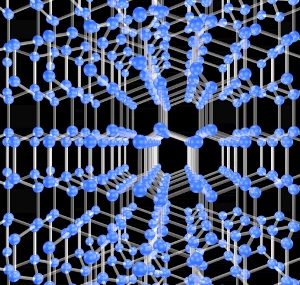Information On Supercooled Water
 |
| A computer simulation of the ice crystal structure. The blue spheres are water molecules. |
Tiny cloud drops can resist freezing down to temperatures as low as minus 40 degrees Fahrenheit. Let me explain. Just as condensation nuclei are required for cloud droplets to form via net condensation of water vapor, freezing nuclei, whose molecular structure resembles the lattice structure of ice, are required for liquid cloud drops to readily freeze into ice crystals in cold sections of clouds. But, because cloud droplets are so small, there's a chance that some cloud drops lack freezing nuclei and thus resist freezing. At temperatures near minus 40 degrees Fahrenheit, however, cloud drops that lack freezing nuclei freeze spontaneously. Indeed, water molecules become so sluggish at such low temperatures that the probability dramatically increases that enough of them will gather around the same site and fall into an ice-lattice alignment.
To see that small drops can resist freezing at low temperatures, consider these two photographs. The photograph on the left shows random small water drops that I placed on the bottom of a used tin can with an eyedropper. Then I placed the can in the freezer (when my wife wasn't looking, of course). After ten minutes or so, I removed the can and took another photograph (on the right). Note that some drops are frozen, while others are not, presumably because they lacked sufficient freezing nuclei for the temperatures in my freezer (ice nuclei are temperature dependent).
Such a result should convince you that even tinier cloud drops can resist freezing far below 32 degrees Fahrenheit. The results of my experiment is one reason why I grimace every time I hear Hale Stone refer to 32 degrees as the "freezing point of water". Hale is treading on very thin ice with such statements. Indeed, most water does NOT freeze at 32 degrees (tap water, for example, is not pure and contains impurities that interfere with the formation of the ice lattice at 32 degrees -- lower temperatures are required to make impure tap water freeze). What Hale should say is that "32 degrees is the melting point of ice" because all ice melts at this temperature. As an apprentice forecaster, please take note that such regular blither by television weathercasters constitutes a lack of solid scientific principle.